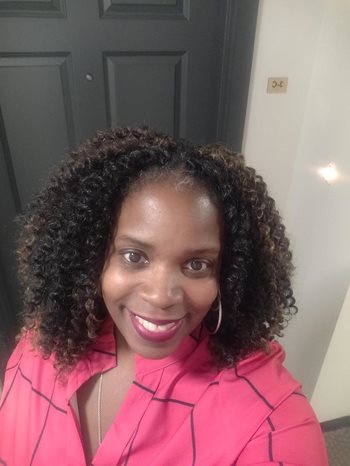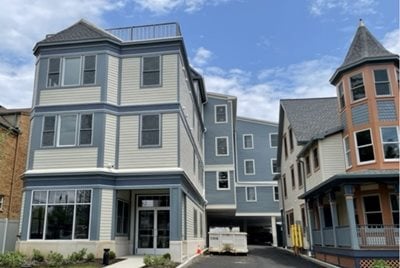In Stamford, Connecticut, a 23-unit condo sits just a block south of the train station. Washington Crossing combines a renovated farmhouse with new construction and is now home to 22 families, with the last family poised to move in this month. All of the families own their condominium homes, which are part of a community land trust.
What's a community land trust? A model of shared equity housing that keeps homes affordable because a nonprofit, like Housing Development Fund (HDF), owns the land, while the homeowner owns the home that sits on that land. The goal is to keep the home affordable for generations.
"We did it very intentionally," explains Joan Carty, president and CEO of HDF, which owns the complex. "Stamford is the most expensive metro area in our state. We realized several years ago that Stamford had become completely out of reach for many low- and moderate-income households. We wanted to develop stock that was in reach for our target market for this development: Households that already live and work in Stamford."

There were some programs that kept things affordable for low-income residents, but she, like many residents, found out that when your income reaches a certain level, your rent goes up. Perry, who has her Juris Doctor and works as a court planner, found herself in what she calls "that gray area."
"The apartments in Stamford were for higher earning people, not middle class," she says. "I was getting priced out and I thought, 'I need to own.' If I own it, I know I can sustain it; I'll have the same mortgage rate for the next 30 years."
But like rental costs, homeownership costs were going up, too, especially during the pandemic. Then she heard about a group of condominium homes available through HDF. Perry took one of the organization's classes, learning more about the model – and about what it means to own a home.
Her biggest takeaway? "The responsibility. You can't just call maintenance. Once you know you own it, everything is on you. But it's okay. It's something I signed up for." And it's something HDF's classes helped her prepare for.
it, everything is on you. But it's okay. It's something I signed up for." And it's something HDF's classes helped her prepare for.
 it, everything is on you. But it's okay. It's something I signed up for." And it's something HDF's classes helped her prepare for.
it, everything is on you. But it's okay. It's something I signed up for." And it's something HDF's classes helped her prepare for.HDF has also served as a Community Development Financial Institution (CDFI) for more than 30 years. Carty says that to solve the affordable housing riddle, her community needed something that was permanently affordable like the condo development. "We're creating a permanent community asset," she says.
The shared equity model also allows residents to not only benefit from a predictable monthly mortgage but to recoup the value of their improvements – and their down payment. The organization and the family share in the appreciation of the home.
"They can leave the unit to their children or someone in their family. Or they can sell and move to another type of housing," Carty explains. "It did just what we were hoping. We'd been counseling people for enough years that the staff felt confident that if we built the product, they will come. And they did."
As construction took place, so did homebuyer readiness. The complications of the pandemic meant a lot of Zoom orientations and outreach, where HDF staff talked about the units. But the bright side, Carty says, is that the orientations could be recorded so the people who registered could listen at any time.
"Then we helped them get ready for counseling," Carty adds. "We talked about paying down debt, increasing savings. Some people were ready and had just not found something they could afford."
The condominiums went for $240,000 to $275,000 in an area where single-family homes usually go for $600,000 and up. Most of the homeowners were able to make their purchases before interest rates increased. Carty says the success of this project has her nonprofit looking for other potential sites to replicate.
"In Stamford, it's a tough place to find land – it's a tight market. But we're looking and we think we'll be able to do it again."
According to Jenee Gaynor, director of Shared Equity Housing at NeighborWorks America, many communities are facing these increased housing and construction costs. "This is one way to serve more families with limited funds and subsidies. It's a way to make sure any investment you're making will really count and stay in the community for the long term."
Especially as more nonprofits are struggling to do more with less.
"Supporting network organizations in adopting and scaling shared equity models that can serve many households over time is one way NeighborWorks is helping the network do more," says Gaynor.
Meanwhile, Perry and her family moved into their new home in September. Now they have three bedrooms and two full bathrooms for her, her 10-year-old daughter and her teenage niece. And Perry knew just how she wanted to arrange everything inside. She's looking forward to time on the rooftop patio with their neighbors once the weather warms up. But the best thing about the condo? "It's mine," she says.
NeighborWorks America opened its most recent round of Shared Equity Housing Initiative awards on Feb. 15. Awards will include capacity-building and production grants, evaluation services and place-based training awards for network organizations exploring, implementing and scaling shared equity housing programs. NeighborWorks network organizations interested in accessing the Grant Opportunity Guide should reach out to [email protected].
Interested in learning more about shared equity housing models? NeighborWorks' recent report and stories offer more information.

